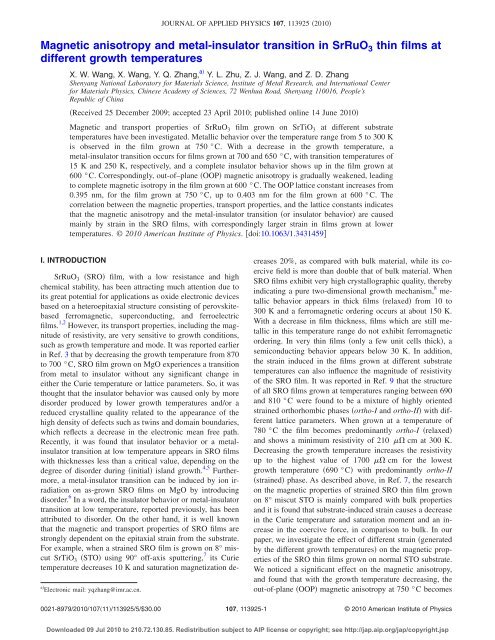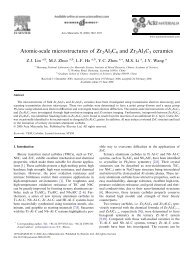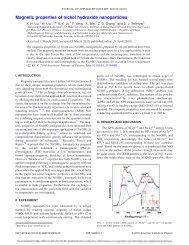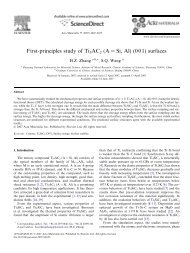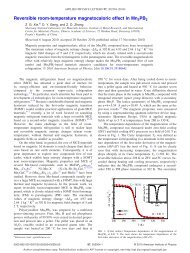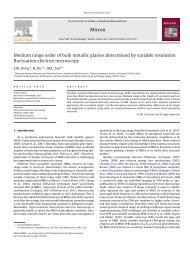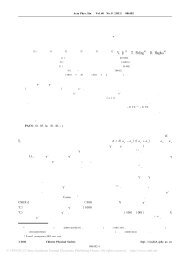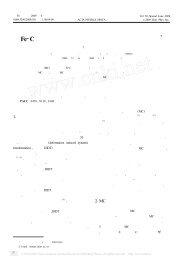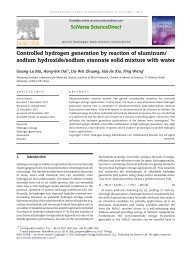Magnetic anisotropy and metal-insulator transition in SrRuO3 thin ...
Magnetic anisotropy and metal-insulator transition in SrRuO3 thin ...
Magnetic anisotropy and metal-insulator transition in SrRuO3 thin ...
You also want an ePaper? Increase the reach of your titles
YUMPU automatically turns print PDFs into web optimized ePapers that Google loves.
JOURNAL OF APPLIED PHYSICS 107, 113925 2010<br />
<strong>Magnetic</strong> <strong>anisotropy</strong> <strong>and</strong> <strong>metal</strong>-<strong><strong>in</strong>sulator</strong> <strong>transition</strong> <strong>in</strong> SrRuO 3 th<strong>in</strong> films at<br />
different growth temperatures<br />
X. W. Wang, X. Wang, Y. Q. Zhang, a Y. L. Zhu, Z. J. Wang, <strong>and</strong> Z. D. Zhang<br />
Shenyang National Laboratory for Materials Science, Institute of Metal Research, <strong>and</strong> International Center<br />
for Materials Physics, Ch<strong>in</strong>ese Academy of Sciences, 72 Wenhua Road, Shenyang 110016, People’s<br />
Republic of Ch<strong>in</strong>a<br />
Received 25 December 2009; accepted 23 April 2010; published onl<strong>in</strong>e 14 June 2010<br />
<strong>Magnetic</strong> <strong>and</strong> transport properties of SrRuO 3 film grown on SrTiO 3 at different substrate<br />
temperatures have been <strong>in</strong>vestigated. Metallic behavior over the temperature range from 5 to 300 K<br />
is observed <strong>in</strong> the film grown at 750 °C. With a decrease <strong>in</strong> the growth temperature, a<br />
<strong>metal</strong>-<strong><strong>in</strong>sulator</strong> <strong>transition</strong> occurs for films grown at 700 <strong>and</strong> 650 °C, with <strong>transition</strong> temperatures of<br />
15 K <strong>and</strong> 250 K, respectively, <strong>and</strong> a complete <strong><strong>in</strong>sulator</strong> behavior shows up <strong>in</strong> the film grown at<br />
600 °C. Correspond<strong>in</strong>gly, out-of–plane OOP magnetic <strong>anisotropy</strong> is gradually weakened, lead<strong>in</strong>g<br />
to complete magnetic isotropy <strong>in</strong> the film grown at 600 °C. The OOP lattice constant <strong>in</strong>creases from<br />
0.395 nm, for the film grown at 750 °C, up to 0.403 nm for the film grown at 600 °C. The<br />
correlation between the magnetic properties, transport properties, <strong>and</strong> the lattice constants <strong>in</strong>dicates<br />
that the magnetic <strong>anisotropy</strong> <strong>and</strong> the <strong>metal</strong>-<strong><strong>in</strong>sulator</strong> <strong>transition</strong> or <strong><strong>in</strong>sulator</strong> behavior are caused<br />
ma<strong>in</strong>ly by stra<strong>in</strong> <strong>in</strong> the SRO films, with correspond<strong>in</strong>gly larger stra<strong>in</strong> <strong>in</strong> films grown at lower<br />
temperatures. © 2010 American Institute of Physics. doi:10.1063/1.3431459<br />
I. INTRODUCTION<br />
a Electronic mail: yqzhang@imr.ac.cn.<br />
SrRuO 3 SRO film, with a low resistance <strong>and</strong> high<br />
chemical stability, has been attract<strong>in</strong>g much attention due to<br />
its great potential for applications as oxide electronic devices<br />
based on a heteroepitaxial structure consist<strong>in</strong>g of perovskitebased<br />
ferromagnetic, superconduct<strong>in</strong>g, <strong>and</strong> ferroelectric<br />
films. 1,2 However, its transport properties, <strong>in</strong>clud<strong>in</strong>g the magnitude<br />
of resistivity, are very sensitive to growth conditions,<br />
such as growth temperature <strong>and</strong> mode. It was reported earlier<br />
<strong>in</strong> Ref. 3 that by decreas<strong>in</strong>g the growth temperature from 870<br />
to 700 °C, SRO film grown on MgO experiences a <strong>transition</strong><br />
from <strong>metal</strong> to <strong><strong>in</strong>sulator</strong> without any significant change <strong>in</strong><br />
either the Curie temperature or lattice parameters. So, it was<br />
thought that the <strong><strong>in</strong>sulator</strong> behavior was caused only by more<br />
disorder produced by lower growth temperatures <strong>and</strong>/or a<br />
reduced crystall<strong>in</strong>e quality related to the appearance of the<br />
high density of defects such as tw<strong>in</strong>s <strong>and</strong> doma<strong>in</strong> boundaries,<br />
which reflects a decrease <strong>in</strong> the electronic mean free path.<br />
Recently, it was found that <strong><strong>in</strong>sulator</strong> behavior or a <strong>metal</strong><strong><strong>in</strong>sulator</strong><br />
<strong>transition</strong> at low temperature appears <strong>in</strong> SRO films<br />
with thicknesses less than a critical value, depend<strong>in</strong>g on the<br />
degree of disorder dur<strong>in</strong>g <strong>in</strong>itial isl<strong>and</strong> growth. 4,5 Furthermore,<br />
a <strong>metal</strong>-<strong><strong>in</strong>sulator</strong> <strong>transition</strong> can be <strong>in</strong>duced by ion irradiation<br />
on as-grown SRO films on MgO by <strong>in</strong>troduc<strong>in</strong>g<br />
disorder. 6 In a word, the <strong><strong>in</strong>sulator</strong> behavior or <strong>metal</strong>-<strong><strong>in</strong>sulator</strong><br />
<strong>transition</strong> at low temperature, reported previously, has been<br />
attributed to disorder. On the other h<strong>and</strong>, it is well known<br />
that the magnetic <strong>and</strong> transport properties of SRO films are<br />
strongly dependent on the epitaxial stra<strong>in</strong> from the substrate.<br />
For example, when a stra<strong>in</strong>ed SRO film is grown on 8° miscut<br />
SrTiO 3 STO us<strong>in</strong>g 90° off-axis sputter<strong>in</strong>g, 7 its Curie<br />
temperature decreases 10 K <strong>and</strong> saturation magnetization decreases<br />
20%, as compared with bulk material, while its coercive<br />
field is more than double that of bulk material. When<br />
SRO films exhibit very high crystallographic quality, thereby<br />
<strong>in</strong>dicat<strong>in</strong>g a pure two-dimensional growth mechanism, 8 <strong>metal</strong>lic<br />
behavior appears <strong>in</strong> thick films relaxed from 10 to<br />
300 K <strong>and</strong> a ferromagnetic order<strong>in</strong>g occurs at about 150 K.<br />
With a decrease <strong>in</strong> film thickness, films which are still <strong>metal</strong>lic<br />
<strong>in</strong> this temperature range do not exhibit ferromagnetic<br />
order<strong>in</strong>g. In very th<strong>in</strong> films only a few unit cells thick, a<br />
semiconduct<strong>in</strong>g behavior appears below 30 K. In addition,<br />
the stra<strong>in</strong> <strong>in</strong>duced <strong>in</strong> the films grown at different substrate<br />
temperatures can also <strong>in</strong>fluence the magnitude of resistivity<br />
of the SRO film. It was reported <strong>in</strong> Ref. 9 that the structure<br />
of all SRO films grown at temperatures rang<strong>in</strong>g between 690<br />
<strong>and</strong> 810 °C were found to be a mixture of highly oriented<br />
stra<strong>in</strong>ed orthorhombic phases ortho-I <strong>and</strong> ortho-II with different<br />
lattice parameters. When grown at a temperature of<br />
780 °C the film becomes predom<strong>in</strong>antly ortho-I relaxed<br />
<strong>and</strong> shows a m<strong>in</strong>imum resistivity of 210 cm at 300 K.<br />
Decreas<strong>in</strong>g the growth temperature <strong>in</strong>creases the resistivity<br />
up to the highest value of 1700 cm for the lowest<br />
growth temperature 690 °C with predom<strong>in</strong>antly ortho-II<br />
stra<strong>in</strong>ed phase. As described above, <strong>in</strong> Ref. 7, the research<br />
on the magnetic properties of stra<strong>in</strong>ed SRO th<strong>in</strong> film grown<br />
on 8° miscut STO is ma<strong>in</strong>ly compared with bulk properties<br />
<strong>and</strong> it is found that substrate-<strong>in</strong>duced stra<strong>in</strong> causes a decrease<br />
<strong>in</strong> the Curie temperature <strong>and</strong> saturation moment <strong>and</strong> an <strong>in</strong>crease<br />
<strong>in</strong> the coercive force, <strong>in</strong> comparison to bulk. In our<br />
paper, we <strong>in</strong>vestigate the effect of different stra<strong>in</strong> generated<br />
by the different growth temperatures on the magnetic properties<br />
of the SRO th<strong>in</strong> films grown on normal STO substrate.<br />
We noticed a significant effect on the magnetic <strong>anisotropy</strong>,<br />
<strong>and</strong> found that with the growth temperature decreas<strong>in</strong>g, the<br />
out-of-plane OOP magnetic <strong>anisotropy</strong> at 750 °C becomes<br />
0021-8979/2010/10711/113925/5/$30.00<br />
107, 113925-1<br />
© 2010 American Institute of Physics<br />
Downloaded 09 Jul 2010 to 210.72.130.85. Redistribution subject to AIP license or copyright; see http://jap.aip.org/jap/copyright.jsp
113925-2 Wang et al. J. Appl. Phys. 107, 113925 2010<br />
gradually weaker result<strong>in</strong>g f<strong>in</strong>ally <strong>in</strong> magnetic isotropy be<strong>in</strong>g<br />
found <strong>in</strong> films grown at 600 °C. In addition, we have conducted<br />
a detailed research on the effect of different stra<strong>in</strong> on<br />
the <strong>metal</strong>-<strong><strong>in</strong>sulator</strong> <strong>transition</strong> <strong>in</strong> SRO th<strong>in</strong> film at different<br />
growth temperatures.<br />
II. EXPERIMENTAL DETAILS<br />
The SRO films with a thickness of 200 nm were grown<br />
on 001 SrTiO 3 substrates by pulsed laser deposition PLD<br />
us<strong>in</strong>g a KrF =248 nm excimer laser, with a flux of approximately<br />
2 J/cm 2 <strong>and</strong> a repetition rate of 2 Hz under a<br />
process pressure of 0.3 mbar of pure O 2 at substrate temperatures<br />
rang<strong>in</strong>g between 600 <strong>and</strong> 750 °C. The films were then<br />
cooled to room temperature at 2 °C per m<strong>in</strong>ute under an<br />
oxygen pressure of 0.4 bar after deposition. Prior to deposition,<br />
the PLD chamber was completely cleaned <strong>and</strong> the other<br />
target <strong>in</strong> the chamber was completely enclosed leav<strong>in</strong>g only<br />
the SRO target was exposed, thus prevent<strong>in</strong>g any crosscontam<strong>in</strong>ation<br />
of the film from the other target. The substrate<br />
was cleaned <strong>in</strong> an ultrasonic bath with acetone followed by<br />
ethanol, with no other pretreatment be<strong>in</strong>g done. The chamber<br />
was then evacuated us<strong>in</strong>g a turbopump down to about 2<br />
10 −7 mbar to remove any extraneous particles. The structural<br />
quality <strong>and</strong> lattice parameters of the th<strong>in</strong> films were<br />
<strong>in</strong>vestigated us<strong>in</strong>g an x-ray diffractometer XRD, D/max-<br />
2000 Cu K =1.5406 Å <strong>and</strong> transmission electron microscope<br />
TEM. Bulk SRO crystallizes <strong>in</strong> an orthorhombic<br />
Pnma structure with lattice parameters a=5.5670 Å, b<br />
=5.5304 Å, <strong>and</strong> c=7.8446 Å. Its lattice parameter is 3.930<br />
Å <strong>in</strong> pseudocubic notation. The planes <strong>and</strong> directions of SRO<br />
referred to <strong>in</strong> this paper are based on the orthorhombic unit<br />
cell. Surface morphology was <strong>in</strong>vestigated us<strong>in</strong>g atomic<br />
force microscopy AFM, Digital Instruments, Nanoscope IV<br />
<strong>in</strong> tapp<strong>in</strong>g mode. <strong>Magnetic</strong> properties were measured by a<br />
superconduct<strong>in</strong>g quantum <strong>in</strong>terference device magnetometer<br />
with magnetic fields up to 70 kOe. Transport properties were<br />
measured <strong>in</strong> the <strong>in</strong>-plane IP direction by the st<strong>and</strong>ard fourterm<strong>in</strong>al<br />
method <strong>in</strong> the range from 5 to 310 K.<br />
III. RESULTS AND DISCUSSION<br />
Figure 1a shows the -2 XRD patterns for SRO films<br />
grown at temperatures from 600 to 750 °C. Only SRO reflections<br />
close to the STO 001-family are found, but when<br />
SRO films are grown on 001 STO, the film can be grown<br />
epitaxially with its 001, 110, or11¯0 planes parallel to<br />
the STO 001 surface. 10 Also, because of the near degeneracy<br />
of the 002 <strong>and</strong> 110 planar spac<strong>in</strong>g of SRO, it is<br />
difficult to absolutely determ<strong>in</strong>e the film orientations with<br />
the -2 XRD patterns as the only reference. Figure 1b is a<br />
cross-sectional TEM image show<strong>in</strong>g the morphology of the<br />
SRO film grown on STO at 700 °C. The <strong>in</strong>terface between<br />
the film <strong>and</strong> the substrate is sharp <strong>and</strong> flat. Electron diffraction<br />
experiments clarify that the as-grown SRO film is composed<br />
of doma<strong>in</strong>s of both 001-oriented <strong>and</strong> 11¯0-oriented,<br />
as shown <strong>in</strong> Figs. 1c <strong>and</strong> 1d, taken from the areas <strong>in</strong>clud<strong>in</strong>g<br />
both the film <strong>and</strong> the substrate. The dimension of each<br />
doma<strong>in</strong> is several hundreds nanometers <strong>in</strong> length, so that<br />
electron diffraction pattern EDP from a s<strong>in</strong>gle doma<strong>in</strong> can<br />
FIG. 1. Color onl<strong>in</strong>e a The -2 XRD patterns for SRO films grown at<br />
substrate temperature rang<strong>in</strong>g from 600 to 750 °C. b The low magnification<br />
TEM micrograph for a cross-sectional film grown at 700 °C. c <strong>and</strong><br />
d Electron diffraction patters of two different regions of SRO film grown<br />
on at 700 °C. e The growth temperature T g dependence of OOP lattice<br />
constants c.<br />
be obta<strong>in</strong>ed. Figure 1c is a superposition of EDPs of 001 f<br />
<strong>and</strong> 100 s , whereas Fig. 1d is a composite EDP of 11¯0 f<br />
<strong>and</strong> 100 s . Subscripts s <strong>and</strong> f denote substrate <strong>and</strong> film, respectively.<br />
The <strong>in</strong>dexation of SRO is based on an orthorhombic<br />
structure. In Fig. 1c, the growth direction of the 001oriented<br />
doma<strong>in</strong> is along 110; while the growth direction of<br />
the 11¯0-oriented doma<strong>in</strong> is also along 110, as shown <strong>in</strong><br />
Fig. 1d. So, the whole SRO film grows along the 110<br />
direction which is very similar to Ref. 11. It is observed <strong>in</strong><br />
Fig. 1e that the calculated OOP lattice constant c <strong>in</strong><br />
pseudocubic notation gradually <strong>in</strong>creases with decreas<strong>in</strong>g<br />
growth temperature. Moreover, a shoulder is observed <strong>in</strong> the<br />
right side of the SRO peak <strong>in</strong> films grown at 650 <strong>and</strong> 700 °C<br />
shown <strong>in</strong> Fig. 1, <strong>in</strong>dicat<strong>in</strong>g an <strong>in</strong>termediate evolution of the<br />
OOP lattice constant that is between 0.403 nm found <strong>in</strong> the<br />
film grown at 600 °C <strong>and</strong> 0.395 nm for the one grown at<br />
750 °C, <strong>and</strong> corresponds to a state of partial stra<strong>in</strong> relaxation.<br />
Figure 2 shows the three-dimensional 3D AFM surface<br />
morphologies of SRO films grown at different temperatures<br />
<strong>and</strong> also of the raw STO substrate. The surface of the raw<br />
STO substrate as reference is very smooth with a roughness<br />
of 0.2 nm 55 m 2 . Irregular 3D isl<strong>and</strong>s are observed <strong>in</strong><br />
the surface of the film grown at 600 °C with these isl<strong>and</strong>s<br />
becom<strong>in</strong>g larger <strong>and</strong> of a more uniform size as the growth<br />
temperature is <strong>in</strong>creased to 650 °C. The isl<strong>and</strong>s then fade as<br />
the temperature reaches 700 °C <strong>and</strong> almost disappear at a<br />
growth temperature of 750 °C. The root-mean-square roughness<br />
of the film surface 55 m 2 is 3.34 nm <strong>and</strong> 3.76 nm<br />
for films grown at 600 °C <strong>and</strong> 650 °C, respectively, <strong>and</strong><br />
becomes 1.12 <strong>and</strong> 0.98 nm for films grown at 700 <strong>and</strong><br />
Downloaded 09 Jul 2010 to 210.72.130.85. Redistribution subject to AIP license or copyright; see http://jap.aip.org/jap/copyright.jsp
113925-3 Wang et al. J. Appl. Phys. 107, 113925 2010<br />
FIG. 2. Color onl<strong>in</strong>e 3D AFM images of raw SRO substrate <strong>and</strong> SRO films grown at different temperatures a 600 °C, b 650 °C, c 700 °C, <strong>and</strong> d<br />
750 °C.<br />
750 °C. This <strong>in</strong>dicates that the film surface first becomes<br />
rough <strong>and</strong> then smooths as <strong>in</strong>creased growth temperature<br />
provides more bond energy.<br />
Figures 3a–3d show magnetic hysteresis loops of<br />
SRO films grown at different temperatures <strong>in</strong> the OOP <strong>and</strong><br />
the IP directions at 10 K. The <strong>in</strong>set of Fig. 3d shows the<br />
growth temperature dependence of the magnetic moment recorded<br />
at 30 kOe 1 Oe equals about 80 A/m <strong>in</strong> the OOP<br />
direction at 10 K. <strong>Magnetic</strong> <strong>anisotropy</strong> is <strong>in</strong> the OOP direction<br />
for the film grown at 750 °C, <strong>in</strong> agreement with Refs.<br />
12 <strong>and</strong> 13. With decreas<strong>in</strong>g growth temperature, the magnetic<br />
<strong>anisotropy</strong> becomes less pronounced <strong>and</strong> more of the<br />
magnetization rotates <strong>in</strong>to the IP direction. F<strong>in</strong>ally, magnetic<br />
isotropy is found <strong>in</strong> the film grown at 600 °C, due to more<br />
<strong>in</strong>duced stra<strong>in</strong> <strong>in</strong> films grown at lower temperatures. Similar<br />
phenomena was also reported <strong>in</strong> other systems such as<br />
CoFe 2 O 4 film, 14 where magnetic <strong>anisotropy</strong> is <strong>in</strong> the IP with<br />
lower temperature growth, <strong>and</strong> an <strong>in</strong>crease <strong>in</strong> growth temperature<br />
shows more magnetization rotat<strong>in</strong>g from IP <strong>in</strong>to<br />
OOP due to stra<strong>in</strong> relaxation. This is <strong>in</strong> agreement with the<br />
Downloaded 09 Jul 2010 to 210.72.130.85. Redistribution subject to AIP license or copyright; see http://jap.aip.org/jap/copyright.jsp
113925-4 Wang et al. J. Appl. Phys. 107, 113925 2010<br />
(a)<br />
(c)<br />
(a)<br />
(b)<br />
FIG. 4. Color onl<strong>in</strong>e a <strong>and</strong> b Temperature dependence of resistivity of<br />
SRO films grown at different temperatures 600, 650, 700, <strong>and</strong> 750 °C.<br />
Inset <strong>in</strong> b: R-T curve of film grown at 650 °C, replotted <strong>in</strong> the temperature<br />
range from 150 to 300 K.<br />
(b)<br />
FIG. 3. Color onl<strong>in</strong>e a–d Hysteresis loops of SRO films grown at<br />
different temperatures 600, 650, 700, <strong>and</strong> 750 °C <strong>in</strong> the OOP <strong>and</strong> <strong>in</strong> the IP<br />
directions at 10 K. Inset <strong>in</strong> d: the growth temperature T g dependence of<br />
magnetic moment recorded at 30 kOe <strong>in</strong> the OOP direction at 10 K.<br />
theory that the magnetic <strong>anisotropy</strong> is modified by a magnetoelastic<br />
coupl<strong>in</strong>g depend<strong>in</strong>g on its magnitude <strong>and</strong> sign. In<br />
addition, Barkhausen jumps were observed <strong>in</strong> the hysteresis<br />
loop between two regions of opposite magnetic field.<br />
Barkhausen jumps, commonly due to the irreversible motion<br />
of the doma<strong>in</strong> walls between the two regions of opposite<br />
magnetiz<strong>in</strong>g forces 15 are not very spectacular <strong>in</strong> themselves<br />
<strong>and</strong> have been reported <strong>in</strong> other references. It can be seen<br />
from the <strong>in</strong>set of Fig. 3d that the magnetic moment of films<br />
grown at 600 <strong>and</strong> 650 °C is almost the same with a value of<br />
about 0.57 B /Ru. at 30 kOe. The magnetic moment <strong>in</strong>creases<br />
with <strong>in</strong>creas<strong>in</strong>g growth temperature <strong>and</strong> to about<br />
1.39 B /Ru. for films grown at 750 °C, agree<strong>in</strong>g closely<br />
with the calculated value of 1.45 B /Ru. 16 The temperature<br />
dependence of the magnetization not shown here was<br />
found to show that the Curie temperature of film grown at<br />
600 °C is around 158 K, <strong>and</strong> <strong>in</strong>creases to about 165 K for<br />
films grown at 750 °C. The decrease <strong>in</strong> the magnetic moment<br />
<strong>and</strong> the Curie temperature with decreas<strong>in</strong>g growth temperature<br />
<strong>in</strong>dicates that these factors are affected <strong>in</strong>versely by<br />
the greater stra<strong>in</strong> produced at lower temperatures. Namely,<br />
larger <strong>in</strong>duced stra<strong>in</strong> <strong>in</strong> films at lower growth temperatures<br />
changes the sp<strong>in</strong>-sp<strong>in</strong> coupl<strong>in</strong>g through a change <strong>in</strong> the Ru–<br />
O–Ru <strong>in</strong>teratomic distance or bond<strong>in</strong>g angles, consequently<br />
result<strong>in</strong>g <strong>in</strong> changes <strong>in</strong> the exchange energy among<br />
sp<strong>in</strong>s. 3,4,16<br />
Figures 4a <strong>and</strong> 4b represent the temperature dependence<br />
of the electrical resistivity of SRO films grown at different<br />
temperatures. When grown at 750 °C, the film exhibits<br />
a typical <strong>metal</strong>lic behavior <strong>in</strong> the whole temperature range<br />
from 5 to 310 K. Its resistivity is about 210 cm at 300<br />
K, which is comparable with that of bulk s<strong>in</strong>gle crystal SRO<br />
about 195 cm. 16 A m<strong>in</strong>imum of resistivity appears at<br />
15 K <strong>in</strong> the film grown at 700 °C. It is commonly thought<br />
(d)<br />
that this phenomenon is due to disorder produced dur<strong>in</strong>g<br />
<strong>in</strong>itial growth. However, the temperature correspond<strong>in</strong>g to<br />
the m<strong>in</strong>imum of its resistivity shifts to 250 K with films<br />
grown at 650 °C. Moreover, the resistivity behavior is <strong><strong>in</strong>sulator</strong><br />
<strong>in</strong> the whole temperature range from 5 to 310 K when<br />
the film was grown at the lowest temperature 600 °C. Resistivity<br />
behavior <strong>in</strong> our case is similar to that reported <strong>in</strong><br />
Refs. 1 <strong>and</strong> 17, where SRO films grown on MgO <strong>and</strong> SRO<br />
films grown on STO experience a <strong>transition</strong> from <strong>metal</strong> to<br />
<strong><strong>in</strong>sulator</strong> when the growth temperature decreases. However,<br />
as mentioned <strong>in</strong> the <strong>in</strong>troduction, when SRO films grown on<br />
MgO, 3 no significant change <strong>in</strong> either Curie temperature or<br />
lattice constant is observed with variation <strong>in</strong> growth temperature.<br />
But <strong>in</strong> our case <strong>and</strong> Ref. 17, OOP lattice constant <strong>in</strong>creases<br />
gradually with decreas<strong>in</strong>g growth temperature, <strong>in</strong>dicat<strong>in</strong>g<br />
that the film has more OOP tensile stra<strong>in</strong> when grown<br />
at lower temperature possibly <strong>in</strong>dicat<strong>in</strong>g a better epitaxial<br />
quality. Furthermore, the Curie temperature <strong>in</strong> Ref. 17 125<br />
K <strong>and</strong> our case 158 K for the film grown at lower temperatures<br />
690 <strong>and</strong> 600 °C both decrease, compared with<br />
ones grown at a higher temperature. In addition, <strong>in</strong> our case,<br />
the magnetic moment of the film grown at 600 °C decreases<br />
slightly more than 60% as compared with the value of the<br />
film grown at 750 °C. So we argue that <strong>metal</strong>-<strong><strong>in</strong>sulator</strong> <strong>transition</strong><br />
<strong>and</strong> <strong><strong>in</strong>sulator</strong> behavior <strong>in</strong> our films grown at lower<br />
temperature are ma<strong>in</strong>ly due to larger stra<strong>in</strong> produced at lower<br />
growth temperature. In addition, 3D isl<strong>and</strong>s observed <strong>in</strong> our<br />
films grown at lower temperatures <strong>in</strong>evitably <strong>in</strong>troduce microstructure<br />
disorder, which also contributes to <strong>metal</strong><strong><strong>in</strong>sulator</strong><br />
<strong>transition</strong> or <strong><strong>in</strong>sulator</strong> behavior.<br />
IV. CONCLUSIONS<br />
In summary, magnetic <strong>and</strong> transport properties of SRO<br />
films grown with a variation <strong>in</strong> growth temperature have<br />
been <strong>in</strong>vestigated. With decreas<strong>in</strong>g growth temperature, OOP<br />
lattice constants <strong>in</strong>crease from 0.395 nm at 750 °C to 0.403<br />
nm at 600 °C, correspond<strong>in</strong>gly, OOP tensile stra<strong>in</strong> <strong>in</strong>creases.<br />
As a result, <strong>metal</strong>lic behavior appears <strong>in</strong> the whole temperature<br />
range from 5 to 300 K for the film grown at 750 °C<br />
<strong>and</strong> a <strong>metal</strong>-<strong><strong>in</strong>sulator</strong> <strong>transition</strong> occurs at 15 K <strong>and</strong> 250 K for<br />
films grown at 700 °C <strong>and</strong> 650 °C, respectively, <strong>and</strong> then a<br />
complete <strong><strong>in</strong>sulator</strong> behavior appears <strong>in</strong> whole measured temperature<br />
range for film grown at 600 °C. At the same time,<br />
OOP magnetic <strong>anisotropy</strong> gradually transforms <strong>in</strong>to mag-<br />
Downloaded 09 Jul 2010 to 210.72.130.85. Redistribution subject to AIP license or copyright; see http://jap.aip.org/jap/copyright.jsp
113925-5 Wang et al. J. Appl. Phys. 107, 113925 2010<br />
netic isotropy. The Curie temperature of 158 K for the film<br />
grown at 600 °C is lower than that of 165 K for the film<br />
grown at 750 °C <strong>and</strong> the magnetic moment of the former<br />
film is only 40% of the latter one. It is concluded that magnetic<br />
<strong>anisotropy</strong> <strong>and</strong> <strong>metal</strong>-<strong><strong>in</strong>sulator</strong> <strong>transition</strong> or <strong><strong>in</strong>sulator</strong><br />
behavior are ma<strong>in</strong>ly caused by stra<strong>in</strong> <strong>in</strong> films grown at different<br />
temperatures.<br />
ACKNOWLEDGMENTS<br />
This work has been supported by the National Natural<br />
Science Foundation of Ch<strong>in</strong>a under Grant No. 50802098, the<br />
Hundred Talents Program of Ch<strong>in</strong>ese Academy of Sciences<br />
<strong>and</strong> the National Basic Research Program No.<br />
2010CB934603 of Ch<strong>in</strong>a, <strong>and</strong> the M<strong>in</strong>istry of Science <strong>and</strong><br />
Technology of Ch<strong>in</strong>a.<br />
1 K. S. Takahashi, A. Sawa, Y. Ishii, H. Akoh, M. Kawasaki, <strong>and</strong> Y. Tokura,<br />
Phys. Rev. B 67, 094413 2003.<br />
2 J. F. Scott, Ferroelectric Memories Spr<strong>in</strong>ger, New York, 2000.<br />
3 Z. Sefrioui, D. Arias, M. A. Navacerrada, M. Varela, G. Loos, M. Lucía, J.<br />
Santamaría, F. Sánchez-Quesada, <strong>and</strong> M. A. López de la Torre, Appl.<br />
Phys. Lett. 73, 3375 1998.<br />
4 D. Toyota, I. Ohkubo, H. Kumigashira, M. Oshima, T. Ohnishi, M. Lippmaa,<br />
M. Takizawa, A. Fujimori, K. Ono, M. Kawasaki, H. Ko<strong>in</strong>uma,<br />
Appl. Phys. Lett. 87, 162508 2005.<br />
5 G. Herranz, B. Mart<strong>in</strong>ez, J. Fontcuberta, F. Sanchez, C. Ferrater, M. V.<br />
Garcia-Cuenca, <strong>and</strong> M. Varela, Phys. Rev. B 67, 174423 2003.<br />
6 Z. Sefrioui, M. A. López de la Torre, D. Arias, M. A. Navacerrada, M.<br />
Varela, M. Lucía, J. Santamaría, <strong>and</strong> F. Sánchez-Quesada, Physica B 259–<br />
261, 938 1999.<br />
7 Q. Gan, R. A. Rao, C. B. Eom, J. L. Garrett, <strong>and</strong> M. Lee, Appl. Phys. Lett.<br />
72, 978 1998.<br />
8 P. Orgiani, C. Aruta, G. Balestr<strong>in</strong>o, S. Lavanga, P. G. Medaglia, <strong>and</strong> A.<br />
Tebano, Eur. Phys. J. B 26, 232002.<br />
9 P. Rundqvist, A. Vorobiev, S. Gevorgian, K. Khamchane, <strong>and</strong> Z. Ivanov, J.<br />
Appl. Phys. 93, 1291 2003.<br />
10 J. C. Jiang, W. Tian, X. Q. Pan, Q. Gan, <strong>and</strong> C. B. Eom, Appl. Phys. Lett.<br />
72, 2963 1998.<br />
11 J. C. Jiang, X. Q. Pan, <strong>and</strong> C. L. Chen, Appl. Phys. Lett. 72, 9091998.<br />
12 L. Kle<strong>in</strong>, J. S. Dodge, T. H. Geballe, A. Kapitulnik, A. F. Marshall, L.<br />
Antognazza, <strong>and</strong> K. Char, Appl. Phys. Lett. 66, 2427 1995.<br />
13 Q. Gan, R. A. Rao, C. B. Eom, L. Wu, <strong>and</strong> F. Tsui, J. Appl. Phys. 85, 5297<br />
1999.<br />
14 P. D. Thang, G. Rijnders, <strong>and</strong> D. H. A. Blank, J. Magn. Magn. Mater. 310,<br />
2621 2007.<br />
15 R. Palai, H. Huht<strong>in</strong>en, J. F. Scott, <strong>and</strong> R. S. Katiyar, Phys. Rev. B 79,<br />
104413 2009.<br />
16 P. B. Allen, H. Berger, O. Chauvet, L. Forro, T. Jarlborg, A. Junod, B.<br />
Revaz, <strong>and</strong> G. Santi, Phys. Rev. B 53, 4393 1996.<br />
17 K. Khamchane, R. Gunnarsson, <strong>and</strong> Z. G. Ivanov, Mater. Res. Soc. Symp.<br />
Proc. 751, Z3.20.1 2003.<br />
Downloaded 09 Jul 2010 to 210.72.130.85. Redistribution subject to AIP license or copyright; see http://jap.aip.org/jap/copyright.jsp


